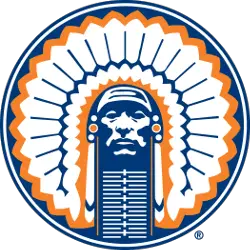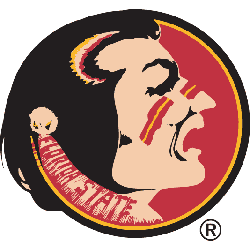The debate regarding Native American nicknames and imagery is nothing new in professional sports, but it is largely a matter of taste.
After several decades’ worth of complaints, the Cleveland Indians did away with their Chief Wahoo mascot in 2018. In the NFL, the Washington Redskins have garnered their fair share of controversy over owner Dan Snyder’s insistence not to drop the nickname, citing the support of the majority of Native Americans over the depiction.

Illinois Fighting Illini Primary Logo 1989 - 2003
It has been a different story in college athletics, however. In 2005, the NCAA alerted several schools to evaluate their nickname and mascot choices if it might fail to adhere to the governing body’s policy to maintain an “atmosphere of respect for and sensitivity to the dignity of every person.”
This resulted in several schools with an “Indians” nickname to change it – for example, the University of Louisiana Monroe is now using Warhawks, while Arkansas State uses Red Wolves.
Some exceptions were made. The University of Illinois was able to keep the Illini nickname as a reference to the state, but they dropped their mascot, Chief Illiniwek.
Waivers were granted to five schools: Catawba College Indians, Central Michigan Chippewas, Mississippi College Choctaws, Utah Utes, and Florida State Seminoles. In those cases, the nicknames were tied into regional tribes and had received their blessing to use the name.
To plead their case, FSU received a written proclamation from the tribe that gave its support to the university to use the Seminole name, logos, and images. They also created a course called “History of the Seminoles and Southeastern Tribes, Pre-Contact to Present,” in order to better educate students on the origins of the nickname.

Florida State Seminoles Primary Logo 1976 - 1989
The relationship, though, wasn’t always so rock solid. The Seminoles' name was selected by a student vote in the 1940s, and the early mascot depictions were more based on stereotypes of Native Americans. When leaders of the Seminole tribe attended a basketball game in the 1970s, they voiced their concerns.
The University responded by retiring their mascots at the time, and in 1978, debuted Osceola and Renegade. Osceola is a student mascot dressed in traditional clothing provided by the Seminole tribe. He rides a horse to midfield prior to football games and plants a flaming spear into the field. The student doesn’t have to be of Seminole descent, but he does need to be in good academic standing and be of good character, according to the FSU website.
During the 2005 NCAA episode, there was some controversy when members of the Seminole tribe residing in Oklahoma (which is a much larger tribe than the Florida contingent) objected to the name and imagery, which landed FSU on the NCAA’s list in the first place.

Florida State Seminoles Primary Logo 2014 - Present
It led to the Seminole National General Council (the legislative body of the Seminole Nation of Oklahoma) to take a vote; the result was 18-2 in favor of not opposing the use of their name by the school.
The interaction between the tribe and the school isn’t just relegated to sporting events. Besides the course being offered, members of the Seminole Nation crown the Homecoming chief and princess with authentic regalia, and men and women from the tribe march in the color guard at graduation ceremonies each year.
Florida State certainly earned the exemption from the NCAA to keep the nickname, as tribe leaders have publicly stated that they feel a true connection with the university and it’s a part of their extended family.
See the Florida State Seminoles logo history and school history.
Sports Logo History is a community of sports logo enthusiast who enjoys the history of each team’s logo history. Sports Logo History has primary logos, alternate logos, wordmark logos or concept logos from the NFL, NBA, MLB, MLS, NHL, Premier League, WNBA, CFL, NCAA, ABA, USFL, AAF, and XFL.
Our partner site is Sports Team History takes a look at the history of each and every professional sports team.

